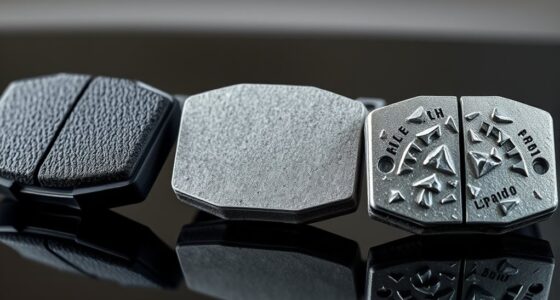To keep your luxury car in top shape when not driven often, regularly maintain the battery with a trickle charger and inspect it for issues. Inflate the tires to recommended pressure, move the vehicle periodically, and consider using jack stands to prevent flat spots. Store the car in a climate-controlled environment with a breathable cover, and clean it thoroughly beforehand. Following these steps will help preserve your car’s condition and performance over time. Keep going to learn more tips for ideal storage.
Key Takeaways
- Disconnect and regularly maintain the battery with a trickle charger to prevent drainage and electrical issues.
- Inflate tires to recommended pressure, and periodically move the vehicle to avoid flat spots.
- Store the car in a climate-controlled environment, protected by a breathable cover to prevent dust and scratches.
- Thoroughly clean the vehicle before storage and use quality products to protect paint and interior surfaces.
- Perform regular inspections, start the engine occasionally, and take short drives if possible to keep mechanical components in good condition.

Storing a luxury car requires careful planning to guarantee it remains in pristine condition during periods of inactivity. When you’re not driving your vehicle regularly, it’s essential to take specific steps to protect its components, especially the battery and tires, which are most vulnerable during storage. Proper battery maintenance involves either disconnecting the battery or using a trickle charger to keep it charged. If you choose to disconnect it, ensure you do it carefully to avoid damaging the electrical system. A trickle charger is a more convenient option, as it maintains the battery’s charge without the need for frequent checks, preventing it from draining completely and potentially becoming unusable. Regularly inspecting the battery during storage helps catch any issues early, saving you from unexpected problems when you’re ready to drive again.
Tire preservation is equally important. When a car sits idle for an extended period, the tires can develop flat spots, leading to uneven wear and a bumpy ride once you start driving again. To prevent this, inflate the tires to the recommended pressure before storing the vehicle. Consider placing the car on jack stands to remove the weight from the tires altogether, especially if you plan on storing it for several months. This reduces the risk of flat spots and helps maintain tire shape and elasticity. If jacking up the car isn’t an option, simply move the vehicle slightly every few weeks to shift the tires’ contact points with the ground, distributing pressure evenly and avoiding permanent indentations.
In addition to battery and tire care, you should also store your luxury car in a climate-controlled environment whenever possible. Extreme temperatures and humidity can accelerate deterioration, affecting paint, interior, and mechanical parts. Cover your vehicle with a breathable car cover to protect it from dust, dirt, and potential scratches. Make sure the cover fits well to prevent it from rubbing against the paint surface. Cleaning your car thoroughly before storage is also vital, as dirt and grime can cause corrosion or staining over time. Use high-quality car care products to protect the paint and interior surfaces. Lastly, periodically starting the engine and taking the car for a short drive can help circulate fluids and keep mechanical components lubricated, though this may not always be practical for long-term storage. Overall, a combination of proper battery maintenance, tire preservation, and environmental control guarantees your luxury car stays in top shape, ready to hit the road when you need it again.
Frequently Asked Questions
How Often Should I Start My Stored Luxury Car?
You should start your stored luxury car about once a month to maintain proper vehicle maintenance. This keeps the engine lubricated and prevents fluid deterioration. During storage preparations, make sure the tires are properly inflated and the battery is maintained or disconnected if necessary. Running the engine briefly helps circulate oil and prevents issues like flat spots on tires, keeping your car in top shape even when it’s not driven regularly.
What Type of Fuel Is Best for Long-Term Storage?
For long-term storage, you should use ethanol-free fuel or add fuel stabilizers to your gas. Ethanol can absorb moisture and cause engine problems, so opting for ethanol-free fuel helps prevent that. Fuel stabilizers keep the fuel fresh and prevent gumming or corrosion. Always fill the tank completely before storage to minimize air and moisture exposure, and run the engine briefly to circulate stabilized fuel through the system.
Can I Store a Luxury Car Outdoors Safely?
Ever wonder if you can leave your luxury car outdoors safely? While outdoor protection is essential, it’s not ideal without proper security measures. Sun, rain, and debris can damage the paint and interior, and theft becomes a real concern. If outdoor storage is your only option, invest in a high-quality cover, security cameras, and a sturdy lock. Otherwise, consider a garage or covered space for peace of mind.
How Do I Prevent Tire Flat Spots During Storage?
To prevent tire flat spots during storage, you should focus on wheel maintenance and tire pressure. Keep your tires inflated to the recommended pressure to evenly distribute weight and avoid deformation. If possible, move the car slightly every few weeks or use tire cradles to reduce contact with the ground. Regularly checking and maintaining proper tire pressure helps guarantee your tires stay in top shape during periods of inactivity.
Should I Disconnect the Car’S Battery Before Storage?
Think of your car’s battery as the heart of its health. During storage preparation, you should disconnect the battery to prevent drain, especially if the vehicle won’t be driven for a while. This simple step helps maintain proper battery maintenance, avoiding issues like a dead battery when you need to hit the road again. Just remember, a little effort now keeps your luxury car in top shape down the line.
Conclusion
Storing a luxury car requires attention and care, but the rewards are worth it. When you safeguard your investment, you preserve its beauty and performance. Neglect might save time now, but costly repairs await later. With proper maintenance and thoughtful storage, your rare vehicle remains pristine, ready to impress. It’s a balance—patience now ensures your car’s shine endures. Keep it protected, and your luxury car will thank you with lasting elegance and power.









